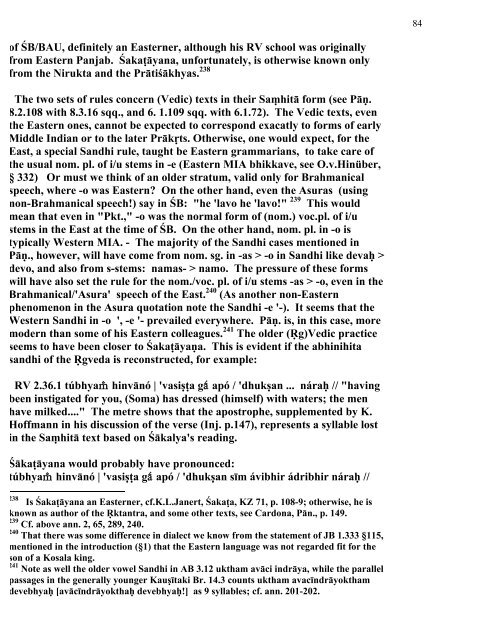TRACING VEDIC DIALECTS - People.fas.harvard.edu
TRACING VEDIC DIALECTS - People.fas.harvard.edu
TRACING VEDIC DIALECTS - People.fas.harvard.edu
Create successful ePaper yourself
Turn your PDF publications into a flip-book with our unique Google optimized e-Paper software.
of ŚB/BAU, definitely an Easterner, although his RV school was originally<br />
from Eastern Panjab. Śakaṭāyana, unfortunately, is otherwise known only<br />
from the Nirukta and the Prātiśākhyas. 238<br />
The two sets of rules concern (Vedic) texts in their Saṃhitā form (see Pāṇ.<br />
8.2.108 with 8.3.16 sqq., and 6. 1.109 sqq. with 6.1.72). The Vedic texts, even<br />
the Eastern ones, cannot be expected to correspond exacatly to forms of early<br />
Middle Indian or to the later Prākṛts. Otherwise, one would expect, for the<br />
East, a special Sandhi rule, taught be Eastern grammarians, to take care of<br />
the usual nom. pl. of i/u stems in -e (Eastern MIA bhikkave, see O.v.Hinüber,<br />
§ 332) Or must we think of an older stratum, valid only for Brahmanical<br />
speech, where -o was Eastern? On the other hand, even the Asuras (using<br />
non-Brahmanical speech!) say in ŚB: "he 'lavo he 'lavo!" 239 This would<br />
mean that even in "Pkt.," -o was the normal form of (nom.) voc.pl. of i/u<br />
stems in the East at the time of ŚB. On the other hand, nom. pl. in -o is<br />
typically Western MIA. - The majority of the Sandhi cases mentioned in<br />
Pāṇ., however, will have come from nom. sg. in -as > -o in Sandhi like devaḥ ><br />
devo, and also from s-stems: namas- > namo. The pressure of these forms<br />
will have also set the rule for the nom./voc. pl. of i/u stems -as > -o, even in the<br />
Brahmanical/'Asura' speech of the East. 240 (As another non-Eastern<br />
phenomenon in the Asura quotation note the Sandhi -e '-). It seems that the<br />
Western Sandhi in -o ', -e '- prevailed everywhere. Pāṇ. is, in this case, more<br />
modern than some of his Eastern colleagues. 241 The older (Ṛg)Vedic practice<br />
seems to have been closer to Śakaṭāyaṇa. This is evident if the abhinihita<br />
sandhi of the Ṛgveda is reconstructed, for example:<br />
RV 2.36.1 túbhya hinvānó | 'vasiṣṭa g apó / 'dhukṣan ... náraḥ // "having<br />
been instigated for you, (Soma) has dressed (himself) with waters; the men<br />
have milked...." The metre shows that the apostrophe, supplemented by K.<br />
Hoffmann in his discussion of the verse (Inj. p.147), represents a syllable lost<br />
in the Saṃhitā text based on Śākalya's reading.<br />
Śākaṭāyana would probably have pronounced:<br />
túbhya hinvānó | 'vasiṣṭa g apó / 'dhukṣan sīm ávibhir ádribhir náraḥ //<br />
238 Is Śakaṭāyana an Easterner, cf.K.L.Janert, Śakaṭa, KZ 71, p. 108-9; otherwise, he is<br />
known as author of the Ṛktantra, and some other texts, see Cardona, Pān., p. 149.<br />
239 Cf. above ann. 2, 65, 289, 240.<br />
240 That there was some difference in dialect we know from the statement of JB 1.333 §115,<br />
mentioned in the introduction (§1) that the Eastern language was not regarded fit for the<br />
son of a Kosala king.<br />
241 Note as well the older vowel Sandhi in AB 3.12 uktham avāci indrāya, while the parallel<br />
passages in the generally younger Kauṣītaki Br. 14.3 counts uktham avacīndrāyoktham<br />
devebhyaḥ [avācīndrāyokthaḥ devebhyaḥ!] as 9 syllables; cf. ann. 201-202.<br />
84
















